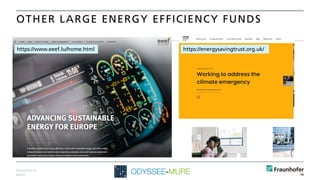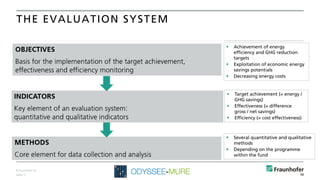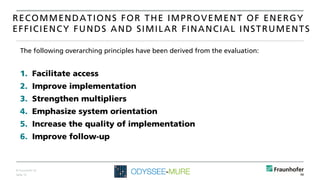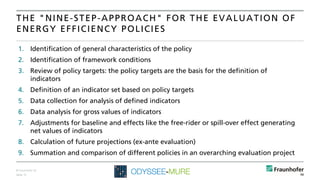Energy Efficiency Funds in Europe
- 1. Webinar in the framework of the project “ODYSSEE-MURE - Monitoring EU Energy Efficiency First Principle and Policy Implementation” 18 January 2022 Energy Efficiency Funds in Europe Dr. Barbara Schlomann Fraunhofer Institute for Systems and Innovation Research ISI Karlsruhe, Germany
- 2. © Fraunhofer ISI Seite 2 Seite 2 THE FRAUNHOFER-GESELLSCHAFT AT A GLANCE
- 3. © Fraunhofer ISI Seite 3 Seite 3 KEY QUESTIONS How do Energy Efficiency Funds contribute to financing energy efficiency investment in the EU? What are the main challenges in evaluating such overarching energy efficiency policies? What could be a suitable evaluation methodology? This presentation discusses the contribution of Energy Efficiency Funds to the financing of energy efficiency investment in the EU. As an example, the German Energy Efficiency Fund and its evaluation is described more detailed. The presentation is based on the MURE database on energy efficiency policies and a policy brief prepared within the ODYSSEE-MURE project (https://www.odyssee-mure.eu/).
- 4. © Fraunhofer ISI Seite 4 Seite 4 https://www.odyssee-mure.eu/ 18 January 2022 Webinar „Energy Efficiency Funds in Europe“
- 5. © Fraunhofer ISI Seite 5 Seite 5 ENERGY EFFICIENCY AS A KEY PILLAR TO REACH AMBITIOUS ENERGY EFFICIENCY AND CLIMATE TARGETS The “Energy Efficiency First” principle plays an important role in the European Green Deal and the “Fit for 55” package. In the proposal for a recast of the Energy Efficiency Directive, a new Article 3 shall ensure that energy efficiency is broadly considered in policy and investment decisions in the Member States. Financing options for energy efficiency investment: Public financing (public budget, tax incentives, special funds) Pay-as-you-go financing (e.g. by allocating investment costs to energy prices) Use of investor capital (e.g. energy performance contracting, crowdfunding) A key challenge of a broad application of the Energy Efficiency First Principle is the financing of energy efficiency investment in all sectors (buildings, services, industry, transport).
- 6. © Fraunhofer ISI Seite 6 Seite 6 GENERAL CHARACTERISTICS OF ENERGY EFFICIENCY FUNDS Financing: mainly through public means, but often independent from volatile public budget (e.g. special funds fed by revenues from EU-ETS or charges on energy prices) Broader than traditional grant or subsidy programmes comprise several progammes and types of instruments (grants, subsidies, information, advice) and often different sectors (buildings, services, industry, transport) Organization: different organizational approaches (from own institutional structure to pure financing bodies) History: first funds started in the early and mid 1990s in UK, Denmark, Czech Republic and some states of the U.S.; continuous diffusion since early 2000s. Focus: early funds only focused on energy efficiency, some later funds also include renewable energies or other
- 7. © Fraunhofer ISI Seite 7 Seite 7 ENERGY EFFICIENCY FUNDS IN MURE
- 8. © Fraunhofer ISI Seite 8 Seite 8 OTHER LARGE ENERGY EFFICIENCY FUNDS https://www.eeef.lu/home.html https://energysavingtrust.org.uk/
- 9. © Fraunhofer ISI Seite 9 Seite 9 EXAMPLE: THE ENERGY EFFICIENCY FUND (EEF) IN GERMANY Established in 2011 to exploit energy savings potential in multiple sectors; in place until 2018 Pure financing body, no institutional structure Financing comes from a special fund which is fed by money from the normal public budget and revenues from EU-ETS Yearly budget strongly increased from 77 MEUR/a to 300 – 500 MEUR/a in later years 23 energy efficiency programs are funded by the EFF addressing all final energy sectors
- 10. © Fraunhofer ISI Seite 10 Seite 10 EVALUATION OF THE GERMAN ENERGY EFFICIENCY FUND The EEF was evaluated by independent research institutions for the years 2011-2017 The evaluation was focused on the legal requirements for the evaluation of programs financed from Federal budgets: Efficiency Effectiveness Target achievement Demands of the Federal Budget Code Cost-effectiveness Check whether the implementation of the measure is cost- effective. 1 2 3 Input of Federal budgets Target-Actual Comparison Comparison of the originally planned objectives with the actually achieved target realization Causality Check whether the measure was appropriate and causative.
- 11. © Fraunhofer ISI Seite 11 Seite 11 THE EVALUATION SYSTEM Achievement of energy efficiency and GHG reduction targets Exploitation of economic energy savings potentials Decreasing energy costs Target achievement (= energy / GHG savings) Effectiveness (= difference gross / net savings) Efficiency (= cost effectiveness) Several quantitative and qualitative methods Depending on the programme within the fund
- 12. © Fraunhofer ISI Seite 12 Seite 12 THE IMPACT OF THE GERMAN ENERGY EFFICIENCY FUND (EVALUATION PERIOD 2011-2017) Cumulated savings in 2017: 3.4 TWh final energy (gross) and 1.2 Mt CO2 reduction Reduction of energy costs: 235 MEUR / a Positive contribution to the German energy efficiency and GHG reduction targets The evaluation method developed for the EEF was generalized and now forms the general guideline for the evaluation of all energy efficiency programmes in Germany Some recommendations from the evaluation for the further development of the EEF were taken up by the Government for a restructuring of the financial support landscape for buildings and industry from 2019
- 13. © Fraunhofer ISI Seite 13 Seite 13 RECOMMENDATIONS FOR THE IMPROVEMENT OF ENERGY EFFICIENCY FUNDS AND SIMILAR FINANCIAL INSTRUMENTS The following overarching principles have been derived from the evaluation: 1. Facilitate access 2. Improve implementation 3. Strengthen multipliers 4. Emphasize system orientation 5. Increase the quality of implementation 6. Improve follow-up
- 14. © Fraunhofer ISI Seite 14 Seite 14 RESTRUCTURING OF THE FINANCIAL SUPPORT PROGRAMMES IN GERMANY SINCE 2019 Cross-cutting structure of the EEF was substituted by sectoral measures bundles for buildings and industry The bundling of different types of policies under the umbrella of an overarching programme was maintained and even strengthened by establishing a uniform access ("one-stop shop): Promotion Strategy for Energy Efficiency and Heat from Renewable Energy Sources Industry Energy efficiency in the economy − subsidy and credit − funding competition Buildings Federal funding for efficient buildings
- 15. © Fraunhofer ISI Seite 15 Seite 15 THE "NINE-STEP-APPROACH" FOR THE EVALUATION OF ENERGY EFFICIENCY POLICIES 1. Identification of general characteristics of the policy 2. Identification of framework conditions 3. Review of policy targets: the policy targets are the basis for the definition of indicators 4. Definition of an indicator set based on policy targets 5. Data collection for analysis of defined indicators 6. Data analysis for gross values of indicators 7. Adjustments for baseline and effects like the free-rider or spill-over effect generating net values of indicators 8. Calculation of future projections (ex-ante evaluation) 9. Summation and comparison of different policies in an overarching evaluation project
- 16. © Fraunhofer ISI Seite 16 Seite 16 KEY MESSAGES Energy Efficiency Funds are an important instrument for financing energy efficiency investment which are implemented at the level of the EU as well as in 9 EU Member States and other European countries and U.S. states. Their main advantages over single financial support programmes are the assurance of longer-term financing through their partial independence from the volatile public budget and their broader cross-technology and cross-sectoral impact. The methodological challenge for the evaluation of such an overarching financial policy is that both the impact of the individual actions and their interaction within the fund must be considered. Well-designed and harmonized policy evaluations can help to improve existing policy measures for energy efficiency and to design new ones.
- 17. © Fraunhofer ISI Seite 17 Seite 17 CONTACT ______________________________________________________ Barbara Schlomann Head of Business Unit Energy Policy Fraunhofer Institute for Systems and Innovation Research ISI Breslauer Strasse 48 | 76139 Karlsruhe | Germany Phone +49 721 6809-136 | Fax +49 721 6809-272 mailto: barbara.schlomann@isi.fraunhofer.de http://www.isi.fraunhofer.de Twitter: @FraunhoferISI

















